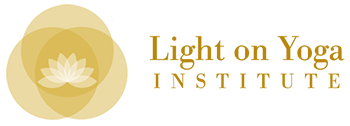When life changes very quickly its natural to feel shaken. Most of us are spending more time at home, now is the time to regulate one’s rhythms with daily practice. Practice is an investment in our well-being which carries us through the challenging times. By attending to the breath, the mind is steadied.
Bhramari pranayama can help with inducing a state of calm, soothing the nerves. Bhramari Pranayama means “bumblebee” and this pranayama produces through exhalation the sound like the humming or buzzing of a bumblebee which is soothing to the mind, and nerves. We can hear the sound clearly (do make sure the sound is up or on in this video).
Here is a demonstration of it practiced in several ways. First practice in a supine position of supported Savasana, which is good for beginners at pranayama, and for experienced practitioners as the beginning of a sequence for pranayama practice, and for assisting with anxiety, insomnia, cold, upper respiratory infection.
Supported Savasana: Support the chest and rib cage with a bolster or neatly stacked folded blankets. The bolster is placed at the bottom of the rib cage. Be sure it is straight. Support the head so that the head tilts downward. The blanket under the head should also support the neck some, but not the shoulders, so that the shoulders release down away from the skull and so that the throat remains soft and passive, releasing backward.
Relax the jaw down, after a normal or deeper inhalation (but not so deep as to invite tension into the body from overdoing) take a pause to switch over to exhalation and allow the exhalation to vibrate in the cavity of the throat, head and upper chest. There should be enough volume of breath that the sound is audible. Make it smooth and even. For that, attention is necessary.
In the demonstration there are several normal breath cycles before demonstrating the pranayama; it is recommended to relax in Savasana, corpse pose, for several minutes, until the body is relaxed before beginning. After one cycle of Bhramari return to normal breathing, and begin another cycle when ready. It can be soothing to focus on the sound of the breath, and one after the other, but it may take practice to reach this level. Keep the eyes closed and soft. If it is difficult to relax the head and facial muscles due to tension wrap the head with a soft cloth bandage. After practicing a number of cycles and without going beyond one’s capacity, relax in Savasana while breathing normally.
Bhramari Pranayama in a seated position is for experienced practitioners of asana/pranayama, who have the strength of body and relaxation of nerves to maintain the lift of the chest. Shown is Swastikasana, or auspicious pose, with support for the buttocks, lower legs. This position recommended for its stability and evenness. The knees should be lower than the front pelvic heads. The back of the palms are supported by trifold blanket. By elevating the hands the neck and shoulders do not have to work as hard to release and let go.
Seated Bhramari is demonstrated with a few cycles of bhramari with different head positions: head bowed down to the chest (Jalandhara Bandha), head level, and head upward.
Head down and head level are easier than raising the head upward, as this last position demands strength from the middle back band to lift the upper chest and release the neck into a backward arching position. When lifting the chest, raise the side chest upward, lift the front armpits up higher, release the top shoulder down, and outer shoulder back. Lift the skin of the chest upward and over the shoulder and down the back.
Inhalation is deep in this demonstration. For Bhramari Pranayama with the head up, inhale then raise the head for exhalation, then lower the head and inhale again.
All of these help with clearing the head, soothing the nerves and may be beneficial for a practitioner in case of an upper respiratory infection, or preventing an infection from deepening. Savasana should be taken afterward and practiced for at least several minutes. It is shown with elevation, support under the chest which is best in cases of illness especially upper respiratory infection, and depression or anxiety. After Savasana following pranayama, try to maintain the quiet of the nervous system. To protect the nerves, wait at least thirty minutes before engaging in stretches or rigorous activity such as asana practice.
Recommended Reading: Light on Pranayama by B.K.S. Iyengar

